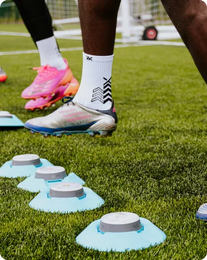Soccer is a game of endurance. Players who can last 90 minutes (or more) while maintaining a high level of agility, flexibility, strength, and quickness will often have a competitive advantage. That’s why endurance training for soccer is a crucial part of any player’s development.

Endurance during a match comes down to your players’ stamina. This is the ability to sustain physical and mental effort for a prolonged period. More than just running around in the field without fatiguing easily, stamina in soccer is the key ingredient to giving your ‘all’ throughout the game. It also takes stamina and endurance to keep up with highly agile opponents.
Much like developing speed through soccer speed drills, stamina can be developed over time using soccer endurance training drills, these drills can be further enhanced by using the BlazePod pods and app, find out which Blazepod training kit fits you best.
Much like speed drills, stamina training for soccer needs to be developed over time. The right combination of endurance and agility ensures players can keep up with the game’s high demands. The following soccer conditioning program focuses on boosting endurance while simulating real-game movements. These drills can be further enhanced by using the BlazePod pods and app, find out which Blazepod training kit fits you best.
How to Build Your Stamina for Soccer
A player’s endurance on the field directly reflects their overall fitness level. Many players struggle on game day because they fail to push themselves hard enough in stamina training for soccer. Simply kicking the ball around at practice isn’t enough—true endurance comes from pushing past limits in training.
Proper endurance training for soccer means getting out of your comfort zone. Players need to challenge their heart, lungs, and muscles beyond what they think is possible. This helps develop perseverance—essential for lasting an entire match at peak performance.
Another key aspect when developing how to build endurance for soccer is ensuring the program is soccer-specific. Players must learn how to train for soccer, incorporating sprints, acceleration, deceleration, directional changes, and recovery jogging.
Coaches should integrate stamina training for soccer that mimics actual match situations. Below are six of the best drills to improve endurance for soccer.
How to Develop Speed Endurance- 6 Soccer Stamina Drills
1. Shuttle Runs
Shuttle runs are among the most effective conditioning drills for soccer, helping players develop speed, acceleration, and anaerobic fitness. An effective drill to add to your soccer fitness drills and workouts, shuttle runs are generally simple and can be done anywhere- in the gym, on pavements, and even on grass.
Set Up and Execution
- Set up 3 cones in a line leaving a distance of 20 and 30 yards between them.
- At the coach’s cue, the player sprints from cone 1 to cone 2, touches the cone, and then sprints back to 1.
- The player then dashes from cone 1 to cone 3, touches the cone, and sprints back to 1 again. That’s one rep.
- Perform 5 repetitions totaling 500 yards.
- Let the players rest for 5 minutes before making another set.
- Time your players and encourage them to try and beat their previous record.
To make these endurance running workouts more effective, the players should change direction snappily and get back to full speed as quickly as possible. You can also get creative by adding a soccer ball to the mix. Pass the ball to the players and have them pass it back when they get to a certain cone.
2. Stop and Go Soccer Endurance Drills
This exercise simulates real in-game movement, alternating between jogging and sprinting to replicate match conditions. It’s one of the best endurance training for soccer drills for improving stamina while preventing injuries.
Set Up and Execution
- This activity involves running around the pitch while alternating between jogs and sprints.
- Let the players warm up to flex their muscles before beginning this drill.
- To begin the exercise, the players start by sprinting at 100% speed from the corner flag to the halfway line.
- From the halfway line, the player decelerates to 50% effort up to the other corner flag.
- Along the goal line, the player slows down to a jog for recovery.
- At the end of the goal line, the player sprints at full speed up to the halfway line.
- Next, they run at 50% effort for the last half before slowing down to a jog at the second goal line.
The players repeat these patterns for 30-45 minutes to simulate one half of a soccer game. If you can’t access the entire field, the players can go around the available half twice to make one rep. When recovering, encourage the players to slow down to a comfortable jog that allows them to catch their breath. They should not stop or walk.
3. Stairs Workout for Stamina and Speed
Running stairs is a great way to increase power, endurance, and overall how to improve stamina for soccer. It’s also an excellent way to enhance anaerobic fitness while working on explosive strength.
Stair running can also be added to your soccer conditioning drills because it increases the heart rate besides training the lungs to take in more oxygen. This, in turn, boosts the player’s VO2 max (maximal oxygen uptake).
Set Up and Execution
- The players should begin by warming up thoroughly. Light jogging for 10-15 minutes and performing high knees, grapevine, and strides are recommendable ways of preparing the muscles and getting the blood flowing.
- After warming up, the player starts running up the flight of stairs to accumulate 30 seconds and then walks down the stairs to recover. That’s one rep.
- Perform 5 reps to make one set and rest for two minutes before completing another set.
As your players get used to these soccer endurance training drills, show them how to engage the entire body to make it an all-around workout. They should maintain a good climbing posture by holding their heads straight with their line of vision locked at the top of the stairs. Also, they should move up by pushing their thighs (not extending their legs) and landing on the balls of their feet.
4. Speed Hill Sprints
Hill sprints require significant mental and physical effort, making them an ideal drill for how to train for soccer while improving endurance. Sprinting on an incline forces players to build strength, speed, and cardiovascular capacity.
Sprinting on a hill is the kind of workout activity that combines strength and speed to give you stronger and faster players. It’s akin to lifting weights while running. This forces your heart and lungs to reach far greater intensities than you usually would.
This drill will be pretty tough for players who are used to exercising on flat terrains. But after a few weeks of training, it will become easier for them to endure sprinting and jogging throughout the match. Besides developing endurance, hill sprints also boost speed and explosiveness- 2 of the most critical assets for a soccer player.
Set Up and Execution
- You’ll need a hill that takes 3 minutes or more to run up.
- Like other soccer endurance training drills, the players need to have warmed up before trying this exercise.
- The players start by running 5 uphill reps of 1-minute each with a jog-down recovery interval after each rep.
- Let them rest for 3 minutes after the first 5 reps.
- Next, they do five 45-sec uphill runs with jog-down recovery followed by a 3-minute rest.
- Then, they perform three 30-second uphill sprints jogging down after each rep to recover. Rest for another 3 minutes.
- Lastly, they run the entire length of the hill (3 minutes), accelerating the last 30 seconds.
This drill builds explosiveness and stamina—both crucial elements in how to improve stamina for soccer.
5. Dribble and Run
This drill improves endurance and ball control, making it one of the best conditioning drills for soccer.
This activity is fairly simple because it’s meant for starters. But you can combine it with other soccer agility drills to make it more challenging as your players’ experience increases.
Set Up and Execution
- The player starts by performing some light warm up activities to loosen up.
- Place a cone along the touchline and another cone directly opposite the first one on the other touchline.
- To start, the player dribbles the ball as fast as possible from the first cone heading towards the second cone.
- Halfway, the player leaves the ball and sprints to the opposite touchline, where he/she goes around the cone.
- Next, the player runs towards the ball and dribbles it back to the starting position.
- The player takes a 1-minute break before making another rep.
- Make 6 reps per session.
One way of making this drill more fun and challenging is to have the players compete. You can also place obstacles along the way, for instance, hurdles or cones that the players have to dribble the ball around or jump to intensify the workout.
6. Planks
Core strength is essential for stamina training for soccer, improving balance, stability, and endurance. Planks engage key muscle groups and should be incorporated into every soccer conditioning program.
Planks are some of the best workouts for developing your core strength. This is because they challenge all the muscles to work together. Of course, it’s important that your players combine planks with other exercises that target the core, including supermans, bridges, flutter kicks, and Russian twists, for quicker results.
Set Up and Execution
- Setting up for planks is pretty simple. First, start by lying belly-side-down on a mat flexing your feet so that the toes are on the mat. Your feet should be less than hip-width apart.
- iNext, with your arms placed on the mat right beside your shoulders, take a deep breath and push your body up by strengthening your arms and lifting your knees and thighs. Keep your elbow locked to ensure stability.
- To reap the full benefits of these exercises, your body needs to be in a straight line with the belly pressed against the spine. Your head also needs to be in a neutral position so that the chin is neither pointing out nor bent towards your chest.
- When done correctly, you should feel the core muscles and glutes engaged and working together.
- When starting, encourage your players to hold this position for 1 minute followed by a 30-second rest before going for another rep.
- Let them complete a total of at least 5 minutes in every training session.
Planks are generally easy to pull off and can be easily incorporated in other soccer workout drills. They are incredibly easy to modify too depending on what you want your players to work on. As your players get used to standard planks, they can try other variations, such as foreman planks, side planks, standard planks with arm and leg extensions, and walking planks.
Conclusion
Building endurance is just as important as mastering ball control in soccer. BlazePod is an advanced training tool that enhances endurance training for soccer, improving reaction speed, agility, and stamina.
Using smart flash reaction training, BlazePod keeps players engaged while ensuring their fitness levels continuously improve. Whether incorporating how to train for soccer or seeking drills for how to improve stamina for soccer, BlazePod offers an innovative way to keep athletes competition-ready.
























